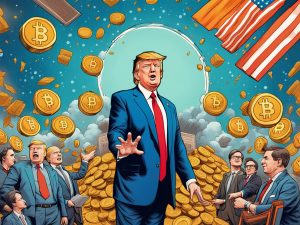Understanding the US Debt Crisis: What If America Defaults? 💰🚨
The United States is facing a significant debt dilemma, with the current debt amounting to a staggering $35.8 trillion—a figure larger than that of any other nation globally. This mounting debt has sparked worries about the possibility of the US government defaulting. Let’s delve into the key aspects of this escalating situation, including the implications of a default and the actions being taken by the US government. Buckle up as we explore the ramifications of this financial predicament!
What Is Government Default? 🤔💵
To grasp the gravity of a potential government default, it’s crucial to understand what it entails. Most governments secure revenue through taxes and fees, which should ideally fund public services, including infrastructure, education, and healthcare. Sadly, many governments spend beyond their means, necessitating borrowing to cover their expenditures.
This borrowing typically occurs through the issuance of government bonds—essentially loans that promise interest payments. Investors view these bonds as secure assets, assuming that governments can either repay the debt via tax collection or through money printing. This perception makes bonds a favored investment choice.
The Impact of a Default: What Could Happen? 📉🌍
Many economists assert that even a brief default by the US could initiate a chaotic global economic crisis. The repercussions would be felt swiftly, primarily due to the reliance of financial systems on US bonds as collateral. A default would generate instability in the bond market, leading to a sharp increase in interest rates—not just for government bonds, but across all forms of borrowing, including mortgages and credit cards.
- Higher interest rates would hinder business operations, pushing some firms to insolvency.
- Increased unemployment could rise by nearly 9%, translating to six million job losses in the US.
- Consumer and investor confidence would plummet, stalling economic growth.
The consequences extend beyond the borders of the US; they could trigger a loss of faith in US treasuries as a safe investment, making it challenging to attract foreign investors. In the unfortunate scenario of a default, stock markets could nosedive by up to 45%, while the US dollar could lose its status as the world’s reserve currency.
Historical Context: Has the US Ever Defaulted? 🏛️📊
Historically, the US has never defaulted on its obligations, unlike several other nations, including Greece and Argentina, which have faced defaults in recent decades. The US has come perilously close to the edge several times—particularly during political impasses regarding the debt ceiling, an established limit on how much the government can borrow.
For instance, the debt ceiling was reached in January of last year, leading to a standoff between President Biden and the Republican-led House of Representatives. This political deadlock raised fears of a funding crisis, prompting drastic measures. Ultimately, an agreement was forged just in time, suspending the debt ceiling until January 2025.
Potential Solutions: Where Do We Go from Here? 🛤️💡
While the US government can pursue several controversial measures to address its debt, options remain limited and contentious. Options include:
- Increased Legal Immigration: This could enhance the labor force and boost tax revenues but faces significant public pushback.
- Raising the Retirement Age: Though it would increase the working population, it might face backlash from seniors who rely on retirement benefits.
- Implementing a National Sales Tax: This could generate immediate revenue but risks increasing the cost of living.
Despite these proposals, the likelihood of significant change appears slim, as most entail some level of societal controversy.
Options for Managing Debt 💸🔄
The US government maintains a few tools to manage its debts. One option is to resume printing money to repurchase its debt—a practice referred to as inflating the debt away. While effective in the short term, this approach typically leads to increased inflation, which diminishes the value of the dollar.
Another possibility involves the Federal Reserve reducing interest rates, easing the debt burden but potentially igniting conflicts with long-term bond investors expecting higher returns.
In most cases, the government likely will continue the cycle of borrowing, raising the debt ceiling as necessary. This cycle perpetuates a growing debt that raises questions about long-term sustainability.
Hot Take: The Future of US Debt and Its Global Implications 🌐🚨
In conclusion, while a US default seems unlikely given historical precedence and necessary actions to prevent it, the implications of such an event would be disastrous for both the US and global economies. The balance lies in managing debt without triggering an irreversible crisis. Investors, regardless of their approach, should remain vigilant about inflationary pressures, reflecting on assets that hold or gain value over time.
Ultimately, while the debate on prudent financial management continues, the emphasis must remain on proactive strategies to avert a situation that could impact countless lives and destabilize economies worldwide.





 By
By
 By
By
 By
By


 By
By